BRE810 Business Research Report: Employee Turnover Analysis
VerifiedAdded on 2022/09/17
|10
|3277
|18
Report
AI Summary
This business research report investigates the factors influencing employee turnover in Australian organizations. The study identifies the increasing turnover rates in the Australian market and the challenges it poses to businesses. The research employs a mixed-method approach, combining quantitative surveys with qualitative interviews to analyze the relationship between performance management practices and employee turnover. The report explores research questions focused on the factors affecting turnover intention, strategies to reduce turnover rates, and the correlation between performance management and turnover. The methodology includes a pragmatic philosophical stance, a deductive approach, and a sequential explanatory research design. The quantitative analysis uses surveys with 385 respondents, while the qualitative analysis involves interviews with managers. The report also reviews existing literature on turnover, including factors like employee satisfaction, training and development, and interpersonal relationships. The expected outcome is to establish an inverse relationship between performance management policies and employee turnover rates, offering insights into how companies can improve employee retention. This report is valuable for anyone seeking to understand and address employee turnover challenges.
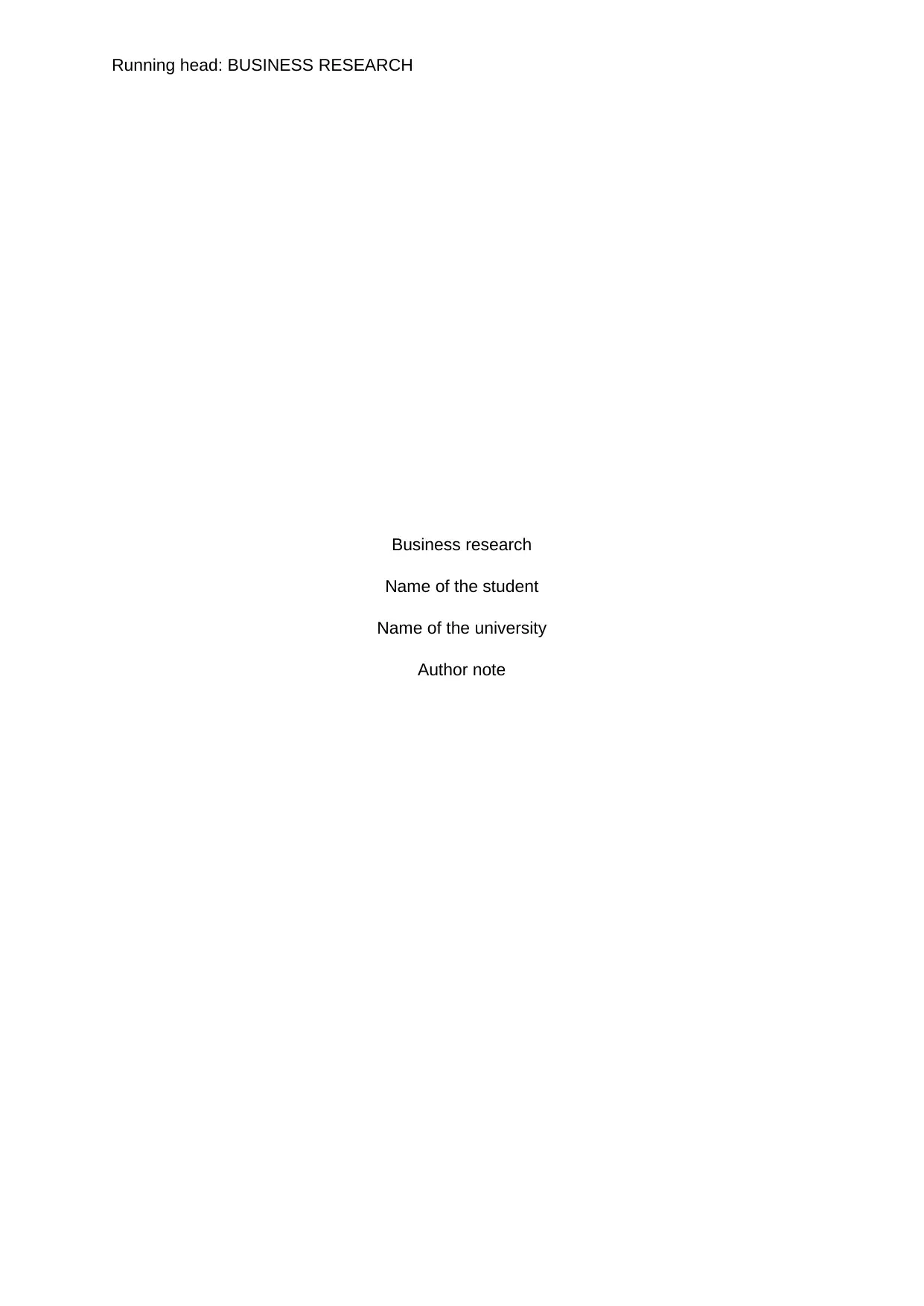
Running head: BUSINESS RESEARCH
Business research
Name of the student
Name of the university
Author note
Business research
Name of the student
Name of the university
Author note
Paraphrase This Document
Need a fresh take? Get an instant paraphrase of this document with our AI Paraphraser
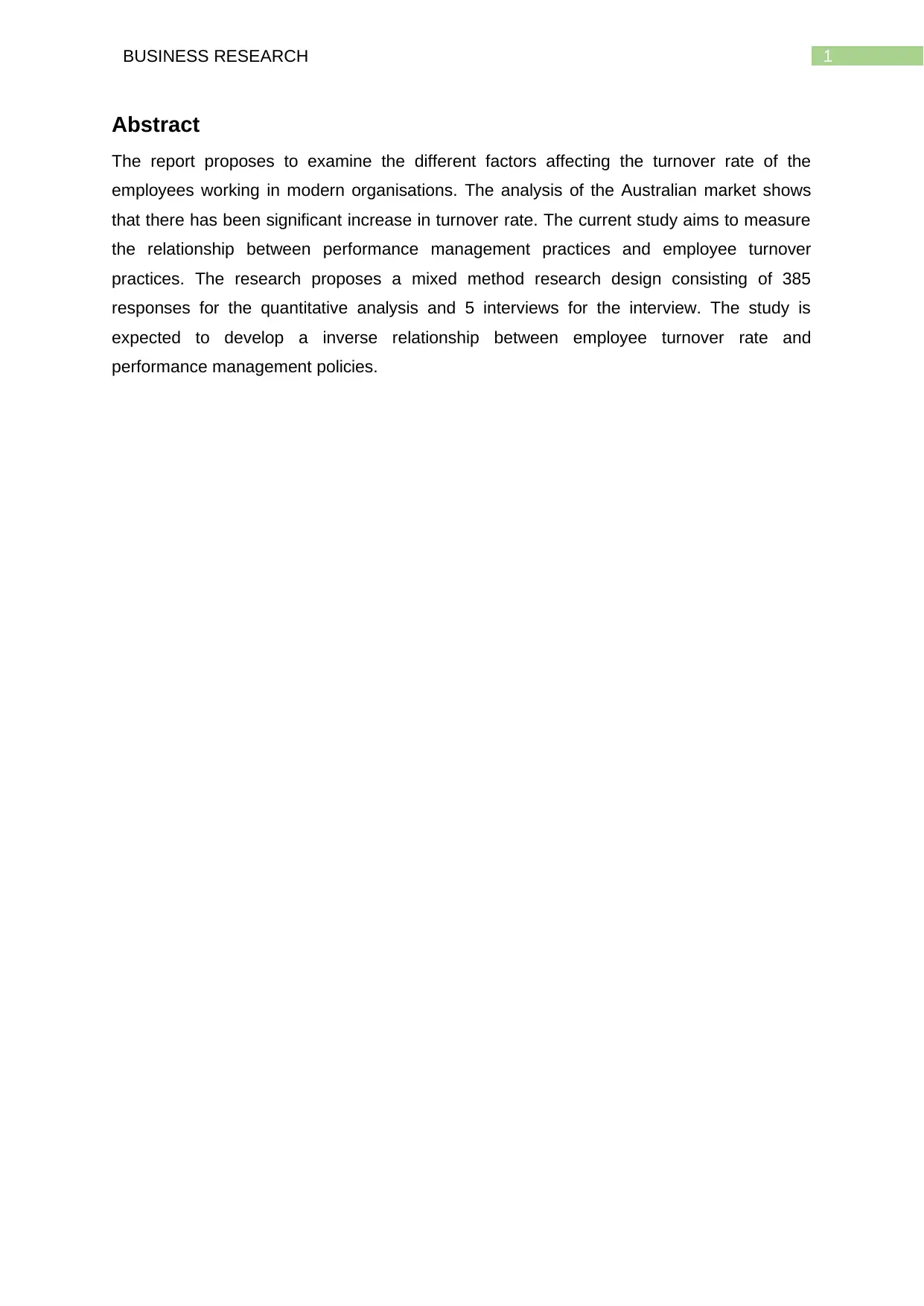
1BUSINESS RESEARCH
Abstract
The report proposes to examine the different factors affecting the turnover rate of the
employees working in modern organisations. The analysis of the Australian market shows
that there has been significant increase in turnover rate. The current study aims to measure
the relationship between performance management practices and employee turnover
practices. The research proposes a mixed method research design consisting of 385
responses for the quantitative analysis and 5 interviews for the interview. The study is
expected to develop a inverse relationship between employee turnover rate and
performance management policies.
Abstract
The report proposes to examine the different factors affecting the turnover rate of the
employees working in modern organisations. The analysis of the Australian market shows
that there has been significant increase in turnover rate. The current study aims to measure
the relationship between performance management practices and employee turnover
practices. The research proposes a mixed method research design consisting of 385
responses for the quantitative analysis and 5 interviews for the interview. The study is
expected to develop a inverse relationship between employee turnover rate and
performance management policies.
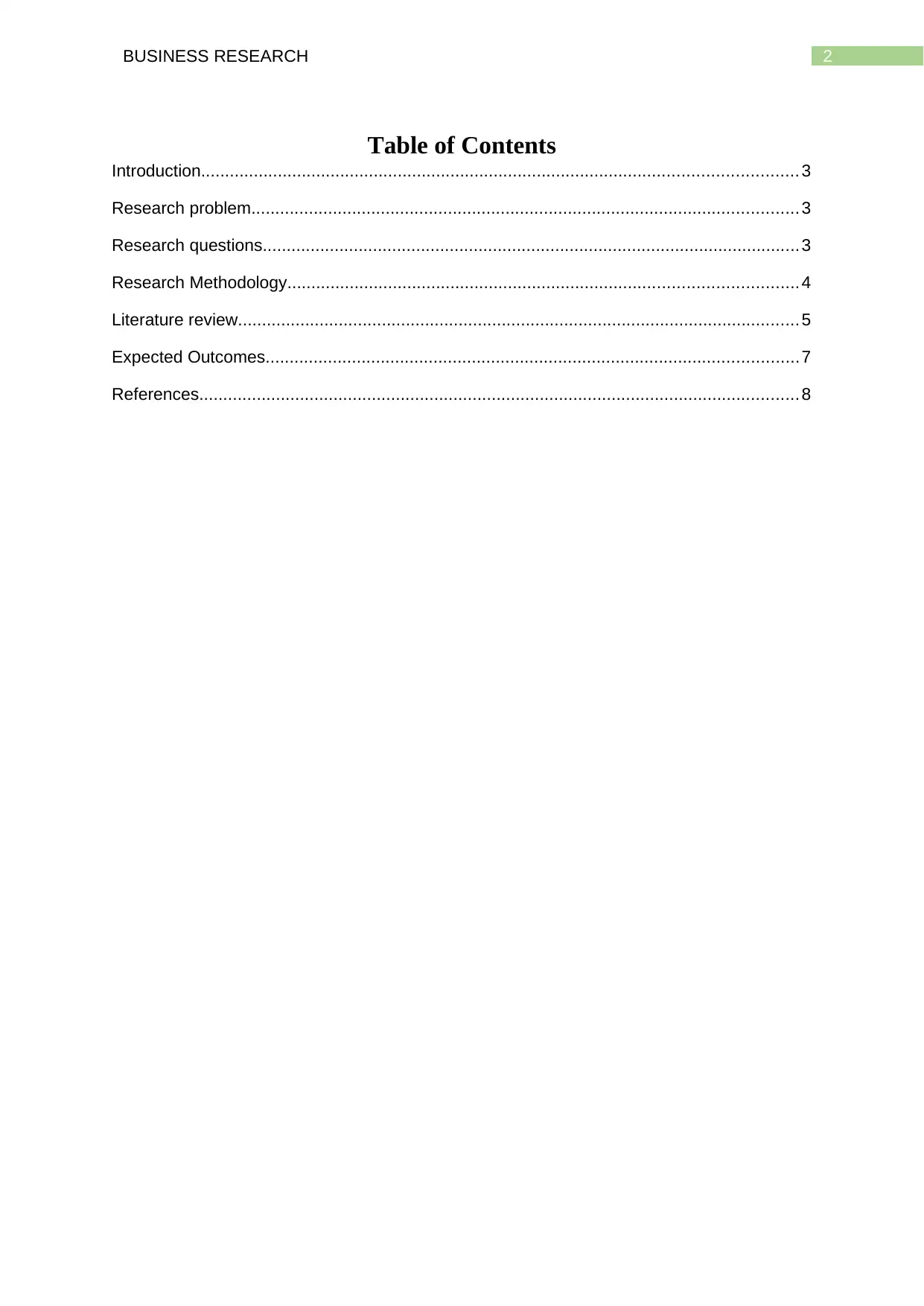
2BUSINESS RESEARCH
Table of Contents
Introduction............................................................................................................................ 3
Research problem.................................................................................................................. 3
Research questions................................................................................................................ 3
Research Methodology.......................................................................................................... 4
Literature review..................................................................................................................... 5
Expected Outcomes...............................................................................................................7
References............................................................................................................................. 8
Table of Contents
Introduction............................................................................................................................ 3
Research problem.................................................................................................................. 3
Research questions................................................................................................................ 3
Research Methodology.......................................................................................................... 4
Literature review..................................................................................................................... 5
Expected Outcomes...............................................................................................................7
References............................................................................................................................. 8
⊘ This is a preview!⊘
Do you want full access?
Subscribe today to unlock all pages.

Trusted by 1+ million students worldwide
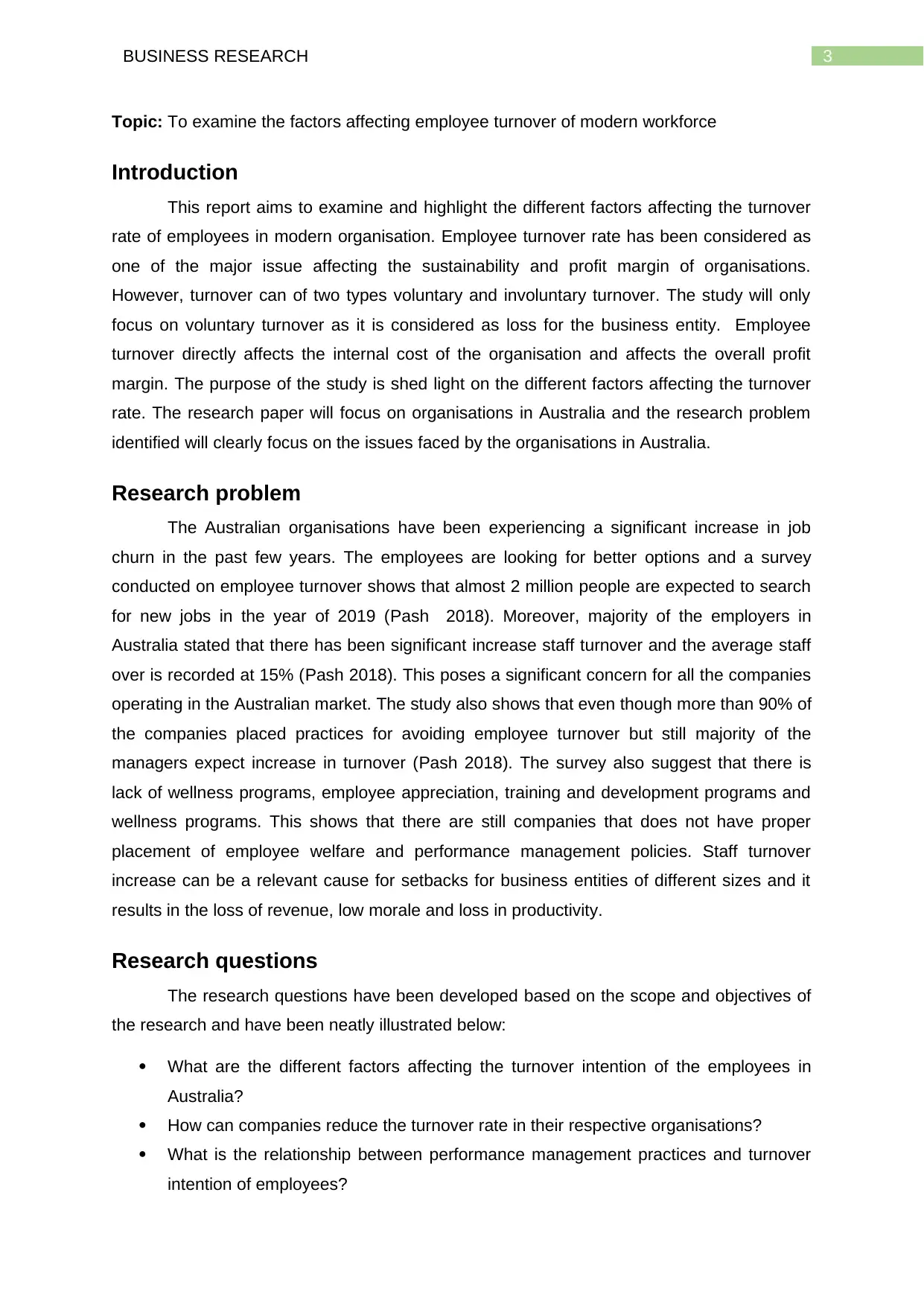
3BUSINESS RESEARCH
Topic: To examine the factors affecting employee turnover of modern workforce
Introduction
This report aims to examine and highlight the different factors affecting the turnover
rate of employees in modern organisation. Employee turnover rate has been considered as
one of the major issue affecting the sustainability and profit margin of organisations.
However, turnover can of two types voluntary and involuntary turnover. The study will only
focus on voluntary turnover as it is considered as loss for the business entity. Employee
turnover directly affects the internal cost of the organisation and affects the overall profit
margin. The purpose of the study is shed light on the different factors affecting the turnover
rate. The research paper will focus on organisations in Australia and the research problem
identified will clearly focus on the issues faced by the organisations in Australia.
Research problem
The Australian organisations have been experiencing a significant increase in job
churn in the past few years. The employees are looking for better options and a survey
conducted on employee turnover shows that almost 2 million people are expected to search
for new jobs in the year of 2019 (Pash 2018). Moreover, majority of the employers in
Australia stated that there has been significant increase staff turnover and the average staff
over is recorded at 15% (Pash 2018). This poses a significant concern for all the companies
operating in the Australian market. The study also shows that even though more than 90% of
the companies placed practices for avoiding employee turnover but still majority of the
managers expect increase in turnover (Pash 2018). The survey also suggest that there is
lack of wellness programs, employee appreciation, training and development programs and
wellness programs. This shows that there are still companies that does not have proper
placement of employee welfare and performance management policies. Staff turnover
increase can be a relevant cause for setbacks for business entities of different sizes and it
results in the loss of revenue, low morale and loss in productivity.
Research questions
The research questions have been developed based on the scope and objectives of
the research and have been neatly illustrated below:
What are the different factors affecting the turnover intention of the employees in
Australia?
How can companies reduce the turnover rate in their respective organisations?
What is the relationship between performance management practices and turnover
intention of employees?
Topic: To examine the factors affecting employee turnover of modern workforce
Introduction
This report aims to examine and highlight the different factors affecting the turnover
rate of employees in modern organisation. Employee turnover rate has been considered as
one of the major issue affecting the sustainability and profit margin of organisations.
However, turnover can of two types voluntary and involuntary turnover. The study will only
focus on voluntary turnover as it is considered as loss for the business entity. Employee
turnover directly affects the internal cost of the organisation and affects the overall profit
margin. The purpose of the study is shed light on the different factors affecting the turnover
rate. The research paper will focus on organisations in Australia and the research problem
identified will clearly focus on the issues faced by the organisations in Australia.
Research problem
The Australian organisations have been experiencing a significant increase in job
churn in the past few years. The employees are looking for better options and a survey
conducted on employee turnover shows that almost 2 million people are expected to search
for new jobs in the year of 2019 (Pash 2018). Moreover, majority of the employers in
Australia stated that there has been significant increase staff turnover and the average staff
over is recorded at 15% (Pash 2018). This poses a significant concern for all the companies
operating in the Australian market. The study also shows that even though more than 90% of
the companies placed practices for avoiding employee turnover but still majority of the
managers expect increase in turnover (Pash 2018). The survey also suggest that there is
lack of wellness programs, employee appreciation, training and development programs and
wellness programs. This shows that there are still companies that does not have proper
placement of employee welfare and performance management policies. Staff turnover
increase can be a relevant cause for setbacks for business entities of different sizes and it
results in the loss of revenue, low morale and loss in productivity.
Research questions
The research questions have been developed based on the scope and objectives of
the research and have been neatly illustrated below:
What are the different factors affecting the turnover intention of the employees in
Australia?
How can companies reduce the turnover rate in their respective organisations?
What is the relationship between performance management practices and turnover
intention of employees?
Paraphrase This Document
Need a fresh take? Get an instant paraphrase of this document with our AI Paraphraser
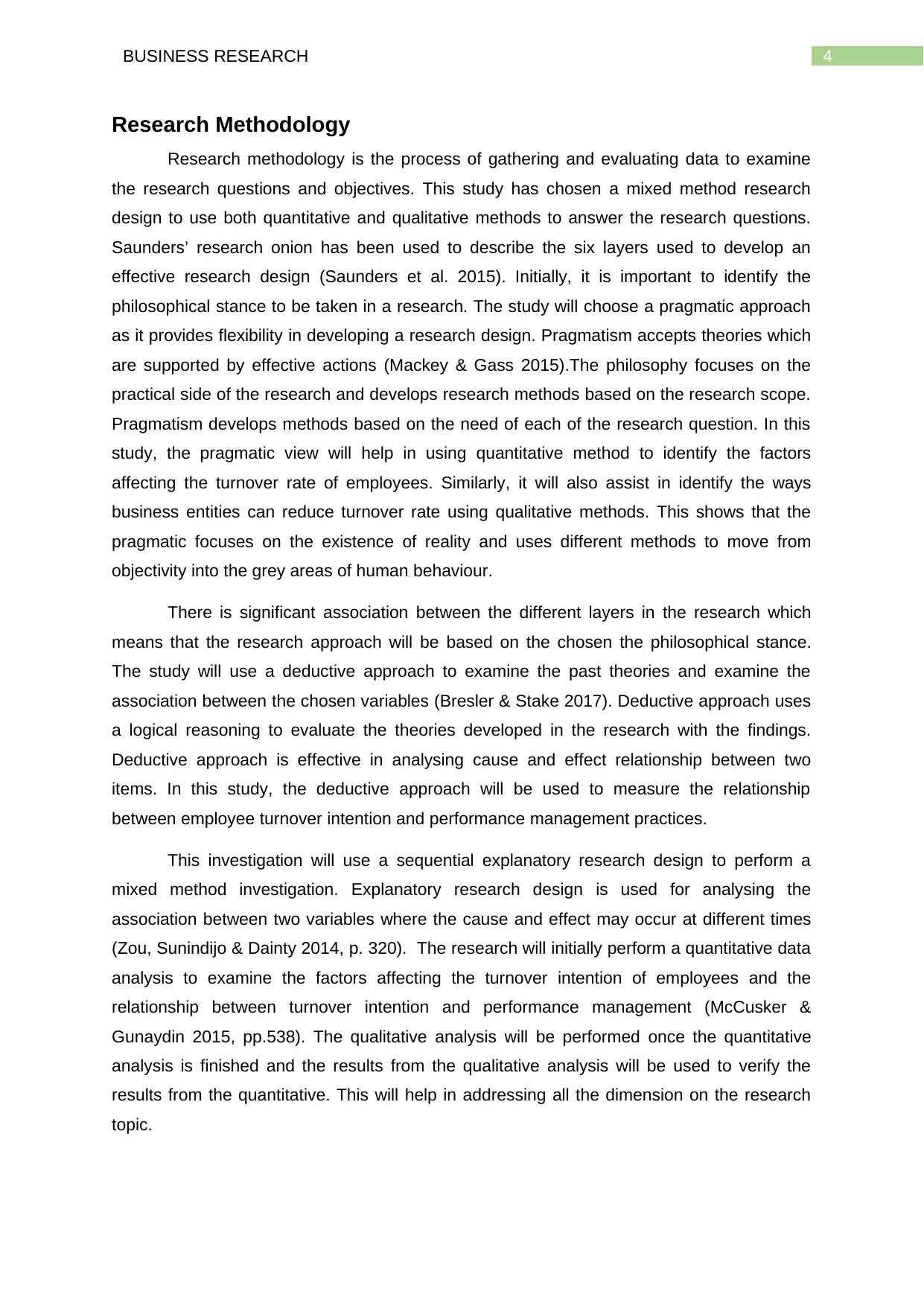
4BUSINESS RESEARCH
Research Methodology
Research methodology is the process of gathering and evaluating data to examine
the research questions and objectives. This study has chosen a mixed method research
design to use both quantitative and qualitative methods to answer the research questions.
Saunders’ research onion has been used to describe the six layers used to develop an
effective research design (Saunders et al. 2015). Initially, it is important to identify the
philosophical stance to be taken in a research. The study will choose a pragmatic approach
as it provides flexibility in developing a research design. Pragmatism accepts theories which
are supported by effective actions (Mackey & Gass 2015).The philosophy focuses on the
practical side of the research and develops research methods based on the research scope.
Pragmatism develops methods based on the need of each of the research question. In this
study, the pragmatic view will help in using quantitative method to identify the factors
affecting the turnover rate of employees. Similarly, it will also assist in identify the ways
business entities can reduce turnover rate using qualitative methods. This shows that the
pragmatic focuses on the existence of reality and uses different methods to move from
objectivity into the grey areas of human behaviour.
There is significant association between the different layers in the research which
means that the research approach will be based on the chosen the philosophical stance.
The study will use a deductive approach to examine the past theories and examine the
association between the chosen variables (Bresler & Stake 2017). Deductive approach uses
a logical reasoning to evaluate the theories developed in the research with the findings.
Deductive approach is effective in analysing cause and effect relationship between two
items. In this study, the deductive approach will be used to measure the relationship
between employee turnover intention and performance management practices.
This investigation will use a sequential explanatory research design to perform a
mixed method investigation. Explanatory research design is used for analysing the
association between two variables where the cause and effect may occur at different times
(Zou, Sunindijo & Dainty 2014, p. 320). The research will initially perform a quantitative data
analysis to examine the factors affecting the turnover intention of employees and the
relationship between turnover intention and performance management (McCusker &
Gunaydin 2015, pp.538). The qualitative analysis will be performed once the quantitative
analysis is finished and the results from the qualitative analysis will be used to verify the
results from the quantitative. This will help in addressing all the dimension on the research
topic.
Research Methodology
Research methodology is the process of gathering and evaluating data to examine
the research questions and objectives. This study has chosen a mixed method research
design to use both quantitative and qualitative methods to answer the research questions.
Saunders’ research onion has been used to describe the six layers used to develop an
effective research design (Saunders et al. 2015). Initially, it is important to identify the
philosophical stance to be taken in a research. The study will choose a pragmatic approach
as it provides flexibility in developing a research design. Pragmatism accepts theories which
are supported by effective actions (Mackey & Gass 2015).The philosophy focuses on the
practical side of the research and develops research methods based on the research scope.
Pragmatism develops methods based on the need of each of the research question. In this
study, the pragmatic view will help in using quantitative method to identify the factors
affecting the turnover rate of employees. Similarly, it will also assist in identify the ways
business entities can reduce turnover rate using qualitative methods. This shows that the
pragmatic focuses on the existence of reality and uses different methods to move from
objectivity into the grey areas of human behaviour.
There is significant association between the different layers in the research which
means that the research approach will be based on the chosen the philosophical stance.
The study will use a deductive approach to examine the past theories and examine the
association between the chosen variables (Bresler & Stake 2017). Deductive approach uses
a logical reasoning to evaluate the theories developed in the research with the findings.
Deductive approach is effective in analysing cause and effect relationship between two
items. In this study, the deductive approach will be used to measure the relationship
between employee turnover intention and performance management practices.
This investigation will use a sequential explanatory research design to perform a
mixed method investigation. Explanatory research design is used for analysing the
association between two variables where the cause and effect may occur at different times
(Zou, Sunindijo & Dainty 2014, p. 320). The research will initially perform a quantitative data
analysis to examine the factors affecting the turnover intention of employees and the
relationship between turnover intention and performance management (McCusker &
Gunaydin 2015, pp.538). The qualitative analysis will be performed once the quantitative
analysis is finished and the results from the qualitative analysis will be used to verify the
results from the quantitative. This will help in addressing all the dimension on the research
topic.
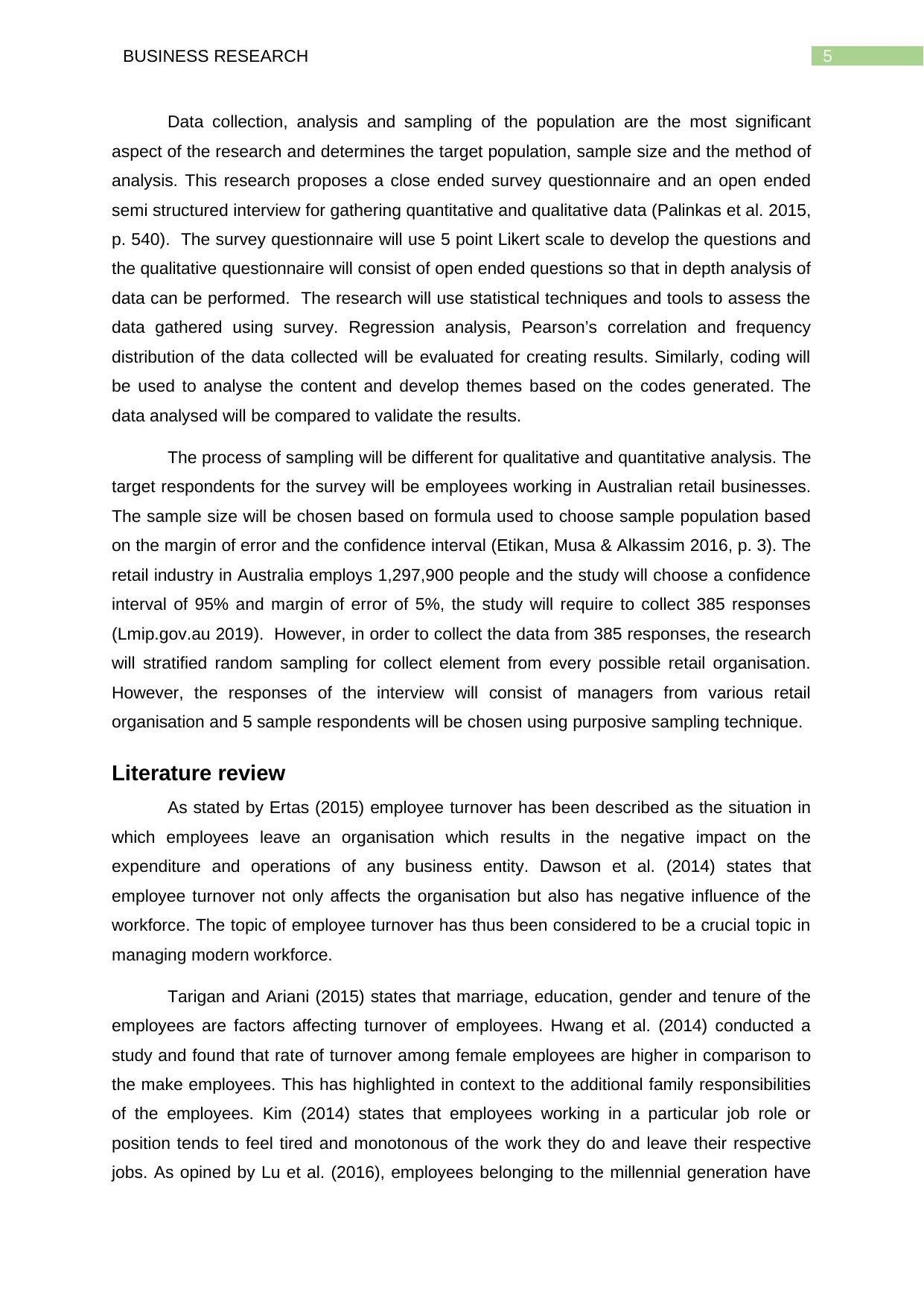
5BUSINESS RESEARCH
Data collection, analysis and sampling of the population are the most significant
aspect of the research and determines the target population, sample size and the method of
analysis. This research proposes a close ended survey questionnaire and an open ended
semi structured interview for gathering quantitative and qualitative data (Palinkas et al. 2015,
p. 540). The survey questionnaire will use 5 point Likert scale to develop the questions and
the qualitative questionnaire will consist of open ended questions so that in depth analysis of
data can be performed. The research will use statistical techniques and tools to assess the
data gathered using survey. Regression analysis, Pearson’s correlation and frequency
distribution of the data collected will be evaluated for creating results. Similarly, coding will
be used to analyse the content and develop themes based on the codes generated. The
data analysed will be compared to validate the results.
The process of sampling will be different for qualitative and quantitative analysis. The
target respondents for the survey will be employees working in Australian retail businesses.
The sample size will be chosen based on formula used to choose sample population based
on the margin of error and the confidence interval (Etikan, Musa & Alkassim 2016, p. 3). The
retail industry in Australia employs 1,297,900 people and the study will choose a confidence
interval of 95% and margin of error of 5%, the study will require to collect 385 responses
(Lmip.gov.au 2019). However, in order to collect the data from 385 responses, the research
will stratified random sampling for collect element from every possible retail organisation.
However, the responses of the interview will consist of managers from various retail
organisation and 5 sample respondents will be chosen using purposive sampling technique.
Literature review
As stated by Ertas (2015) employee turnover has been described as the situation in
which employees leave an organisation which results in the negative impact on the
expenditure and operations of any business entity. Dawson et al. (2014) states that
employee turnover not only affects the organisation but also has negative influence of the
workforce. The topic of employee turnover has thus been considered to be a crucial topic in
managing modern workforce.
Tarigan and Ariani (2015) states that marriage, education, gender and tenure of the
employees are factors affecting turnover of employees. Hwang et al. (2014) conducted a
study and found that rate of turnover among female employees are higher in comparison to
the make employees. This has highlighted in context to the additional family responsibilities
of the employees. Kim (2014) states that employees working in a particular job role or
position tends to feel tired and monotonous of the work they do and leave their respective
jobs. As opined by Lu et al. (2016), employees belonging to the millennial generation have
Data collection, analysis and sampling of the population are the most significant
aspect of the research and determines the target population, sample size and the method of
analysis. This research proposes a close ended survey questionnaire and an open ended
semi structured interview for gathering quantitative and qualitative data (Palinkas et al. 2015,
p. 540). The survey questionnaire will use 5 point Likert scale to develop the questions and
the qualitative questionnaire will consist of open ended questions so that in depth analysis of
data can be performed. The research will use statistical techniques and tools to assess the
data gathered using survey. Regression analysis, Pearson’s correlation and frequency
distribution of the data collected will be evaluated for creating results. Similarly, coding will
be used to analyse the content and develop themes based on the codes generated. The
data analysed will be compared to validate the results.
The process of sampling will be different for qualitative and quantitative analysis. The
target respondents for the survey will be employees working in Australian retail businesses.
The sample size will be chosen based on formula used to choose sample population based
on the margin of error and the confidence interval (Etikan, Musa & Alkassim 2016, p. 3). The
retail industry in Australia employs 1,297,900 people and the study will choose a confidence
interval of 95% and margin of error of 5%, the study will require to collect 385 responses
(Lmip.gov.au 2019). However, in order to collect the data from 385 responses, the research
will stratified random sampling for collect element from every possible retail organisation.
However, the responses of the interview will consist of managers from various retail
organisation and 5 sample respondents will be chosen using purposive sampling technique.
Literature review
As stated by Ertas (2015) employee turnover has been described as the situation in
which employees leave an organisation which results in the negative impact on the
expenditure and operations of any business entity. Dawson et al. (2014) states that
employee turnover not only affects the organisation but also has negative influence of the
workforce. The topic of employee turnover has thus been considered to be a crucial topic in
managing modern workforce.
Tarigan and Ariani (2015) states that marriage, education, gender and tenure of the
employees are factors affecting turnover of employees. Hwang et al. (2014) conducted a
study and found that rate of turnover among female employees are higher in comparison to
the make employees. This has highlighted in context to the additional family responsibilities
of the employees. Kim (2014) states that employees working in a particular job role or
position tends to feel tired and monotonous of the work they do and leave their respective
jobs. As opined by Lu et al. (2016), employees belonging to the millennial generation have
⊘ This is a preview!⊘
Do you want full access?
Subscribe today to unlock all pages.

Trusted by 1+ million students worldwide
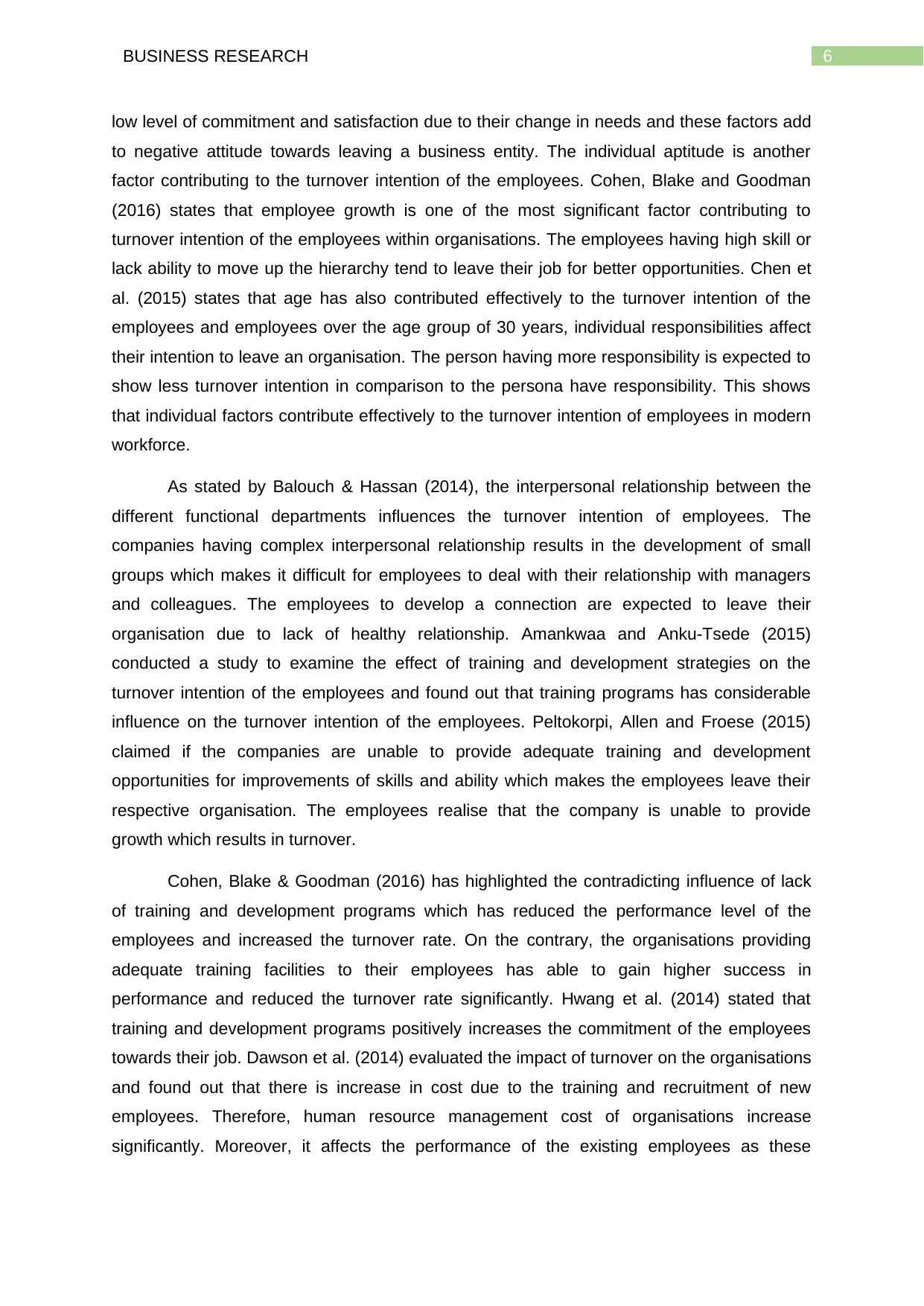
6BUSINESS RESEARCH
low level of commitment and satisfaction due to their change in needs and these factors add
to negative attitude towards leaving a business entity. The individual aptitude is another
factor contributing to the turnover intention of the employees. Cohen, Blake and Goodman
(2016) states that employee growth is one of the most significant factor contributing to
turnover intention of the employees within organisations. The employees having high skill or
lack ability to move up the hierarchy tend to leave their job for better opportunities. Chen et
al. (2015) states that age has also contributed effectively to the turnover intention of the
employees and employees over the age group of 30 years, individual responsibilities affect
their intention to leave an organisation. The person having more responsibility is expected to
show less turnover intention in comparison to the persona have responsibility. This shows
that individual factors contribute effectively to the turnover intention of employees in modern
workforce.
As stated by Balouch & Hassan (2014), the interpersonal relationship between the
different functional departments influences the turnover intention of employees. The
companies having complex interpersonal relationship results in the development of small
groups which makes it difficult for employees to deal with their relationship with managers
and colleagues. The employees to develop a connection are expected to leave their
organisation due to lack of healthy relationship. Amankwaa and Anku-Tsede (2015)
conducted a study to examine the effect of training and development strategies on the
turnover intention of the employees and found out that training programs has considerable
influence on the turnover intention of the employees. Peltokorpi, Allen and Froese (2015)
claimed if the companies are unable to provide adequate training and development
opportunities for improvements of skills and ability which makes the employees leave their
respective organisation. The employees realise that the company is unable to provide
growth which results in turnover.
Cohen, Blake & Goodman (2016) has highlighted the contradicting influence of lack
of training and development programs which has reduced the performance level of the
employees and increased the turnover rate. On the contrary, the organisations providing
adequate training facilities to their employees has able to gain higher success in
performance and reduced the turnover rate significantly. Hwang et al. (2014) stated that
training and development programs positively increases the commitment of the employees
towards their job. Dawson et al. (2014) evaluated the impact of turnover on the organisations
and found out that there is increase in cost due to the training and recruitment of new
employees. Therefore, human resource management cost of organisations increase
significantly. Moreover, it affects the performance of the existing employees as these
low level of commitment and satisfaction due to their change in needs and these factors add
to negative attitude towards leaving a business entity. The individual aptitude is another
factor contributing to the turnover intention of the employees. Cohen, Blake and Goodman
(2016) states that employee growth is one of the most significant factor contributing to
turnover intention of the employees within organisations. The employees having high skill or
lack ability to move up the hierarchy tend to leave their job for better opportunities. Chen et
al. (2015) states that age has also contributed effectively to the turnover intention of the
employees and employees over the age group of 30 years, individual responsibilities affect
their intention to leave an organisation. The person having more responsibility is expected to
show less turnover intention in comparison to the persona have responsibility. This shows
that individual factors contribute effectively to the turnover intention of employees in modern
workforce.
As stated by Balouch & Hassan (2014), the interpersonal relationship between the
different functional departments influences the turnover intention of employees. The
companies having complex interpersonal relationship results in the development of small
groups which makes it difficult for employees to deal with their relationship with managers
and colleagues. The employees to develop a connection are expected to leave their
organisation due to lack of healthy relationship. Amankwaa and Anku-Tsede (2015)
conducted a study to examine the effect of training and development strategies on the
turnover intention of the employees and found out that training programs has considerable
influence on the turnover intention of the employees. Peltokorpi, Allen and Froese (2015)
claimed if the companies are unable to provide adequate training and development
opportunities for improvements of skills and ability which makes the employees leave their
respective organisation. The employees realise that the company is unable to provide
growth which results in turnover.
Cohen, Blake & Goodman (2016) has highlighted the contradicting influence of lack
of training and development programs which has reduced the performance level of the
employees and increased the turnover rate. On the contrary, the organisations providing
adequate training facilities to their employees has able to gain higher success in
performance and reduced the turnover rate significantly. Hwang et al. (2014) stated that
training and development programs positively increases the commitment of the employees
towards their job. Dawson et al. (2014) evaluated the impact of turnover on the organisations
and found out that there is increase in cost due to the training and recruitment of new
employees. Therefore, human resource management cost of organisations increase
significantly. Moreover, it affects the performance of the existing employees as these
Paraphrase This Document
Need a fresh take? Get an instant paraphrase of this document with our AI Paraphraser
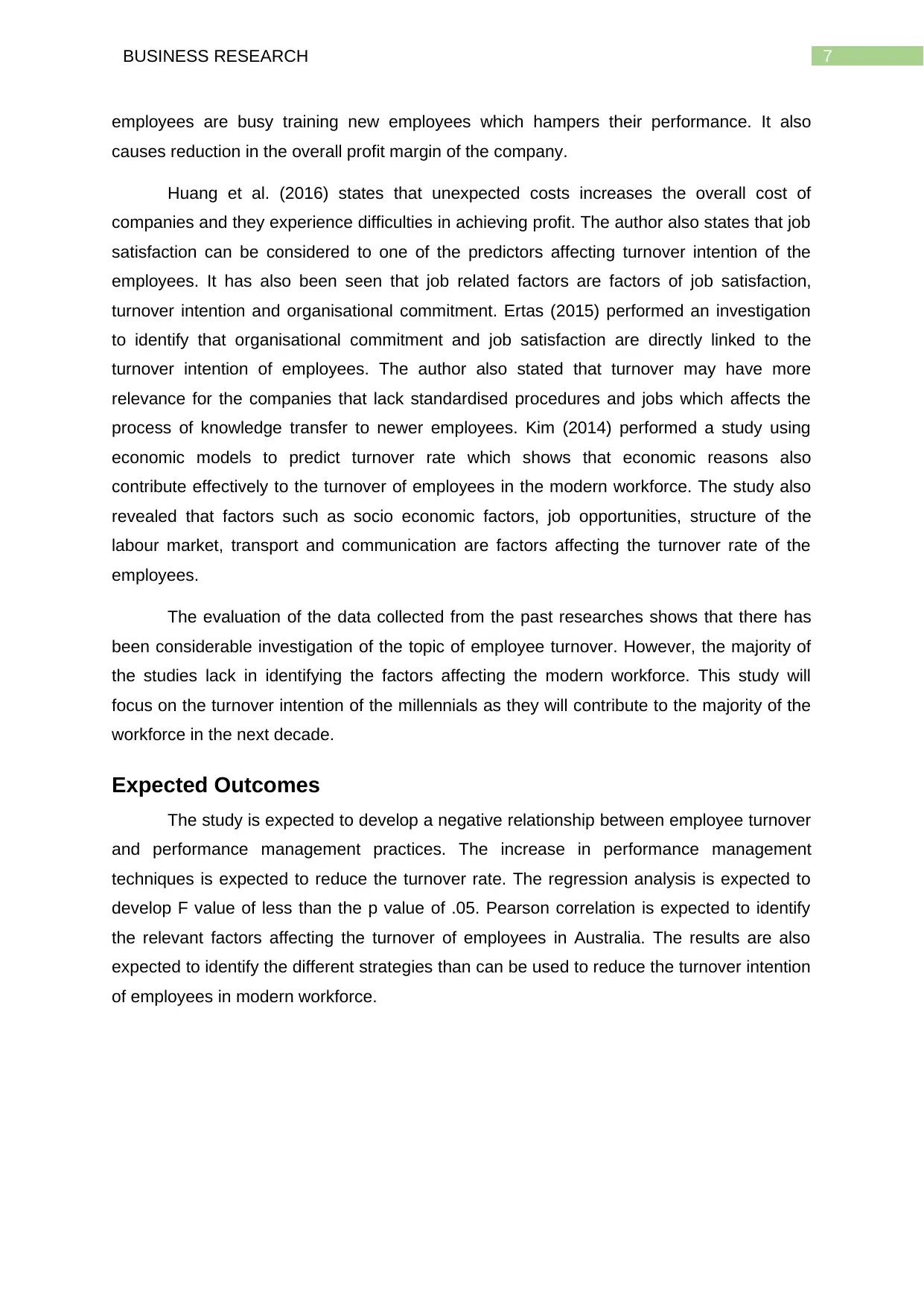
7BUSINESS RESEARCH
employees are busy training new employees which hampers their performance. It also
causes reduction in the overall profit margin of the company.
Huang et al. (2016) states that unexpected costs increases the overall cost of
companies and they experience difficulties in achieving profit. The author also states that job
satisfaction can be considered to one of the predictors affecting turnover intention of the
employees. It has also been seen that job related factors are factors of job satisfaction,
turnover intention and organisational commitment. Ertas (2015) performed an investigation
to identify that organisational commitment and job satisfaction are directly linked to the
turnover intention of employees. The author also stated that turnover may have more
relevance for the companies that lack standardised procedures and jobs which affects the
process of knowledge transfer to newer employees. Kim (2014) performed a study using
economic models to predict turnover rate which shows that economic reasons also
contribute effectively to the turnover of employees in the modern workforce. The study also
revealed that factors such as socio economic factors, job opportunities, structure of the
labour market, transport and communication are factors affecting the turnover rate of the
employees.
The evaluation of the data collected from the past researches shows that there has
been considerable investigation of the topic of employee turnover. However, the majority of
the studies lack in identifying the factors affecting the modern workforce. This study will
focus on the turnover intention of the millennials as they will contribute to the majority of the
workforce in the next decade.
Expected Outcomes
The study is expected to develop a negative relationship between employee turnover
and performance management practices. The increase in performance management
techniques is expected to reduce the turnover rate. The regression analysis is expected to
develop F value of less than the p value of .05. Pearson correlation is expected to identify
the relevant factors affecting the turnover of employees in Australia. The results are also
expected to identify the different strategies than can be used to reduce the turnover intention
of employees in modern workforce.
employees are busy training new employees which hampers their performance. It also
causes reduction in the overall profit margin of the company.
Huang et al. (2016) states that unexpected costs increases the overall cost of
companies and they experience difficulties in achieving profit. The author also states that job
satisfaction can be considered to one of the predictors affecting turnover intention of the
employees. It has also been seen that job related factors are factors of job satisfaction,
turnover intention and organisational commitment. Ertas (2015) performed an investigation
to identify that organisational commitment and job satisfaction are directly linked to the
turnover intention of employees. The author also stated that turnover may have more
relevance for the companies that lack standardised procedures and jobs which affects the
process of knowledge transfer to newer employees. Kim (2014) performed a study using
economic models to predict turnover rate which shows that economic reasons also
contribute effectively to the turnover of employees in the modern workforce. The study also
revealed that factors such as socio economic factors, job opportunities, structure of the
labour market, transport and communication are factors affecting the turnover rate of the
employees.
The evaluation of the data collected from the past researches shows that there has
been considerable investigation of the topic of employee turnover. However, the majority of
the studies lack in identifying the factors affecting the modern workforce. This study will
focus on the turnover intention of the millennials as they will contribute to the majority of the
workforce in the next decade.
Expected Outcomes
The study is expected to develop a negative relationship between employee turnover
and performance management practices. The increase in performance management
techniques is expected to reduce the turnover rate. The regression analysis is expected to
develop F value of less than the p value of .05. Pearson correlation is expected to identify
the relevant factors affecting the turnover of employees in Australia. The results are also
expected to identify the different strategies than can be used to reduce the turnover intention
of employees in modern workforce.
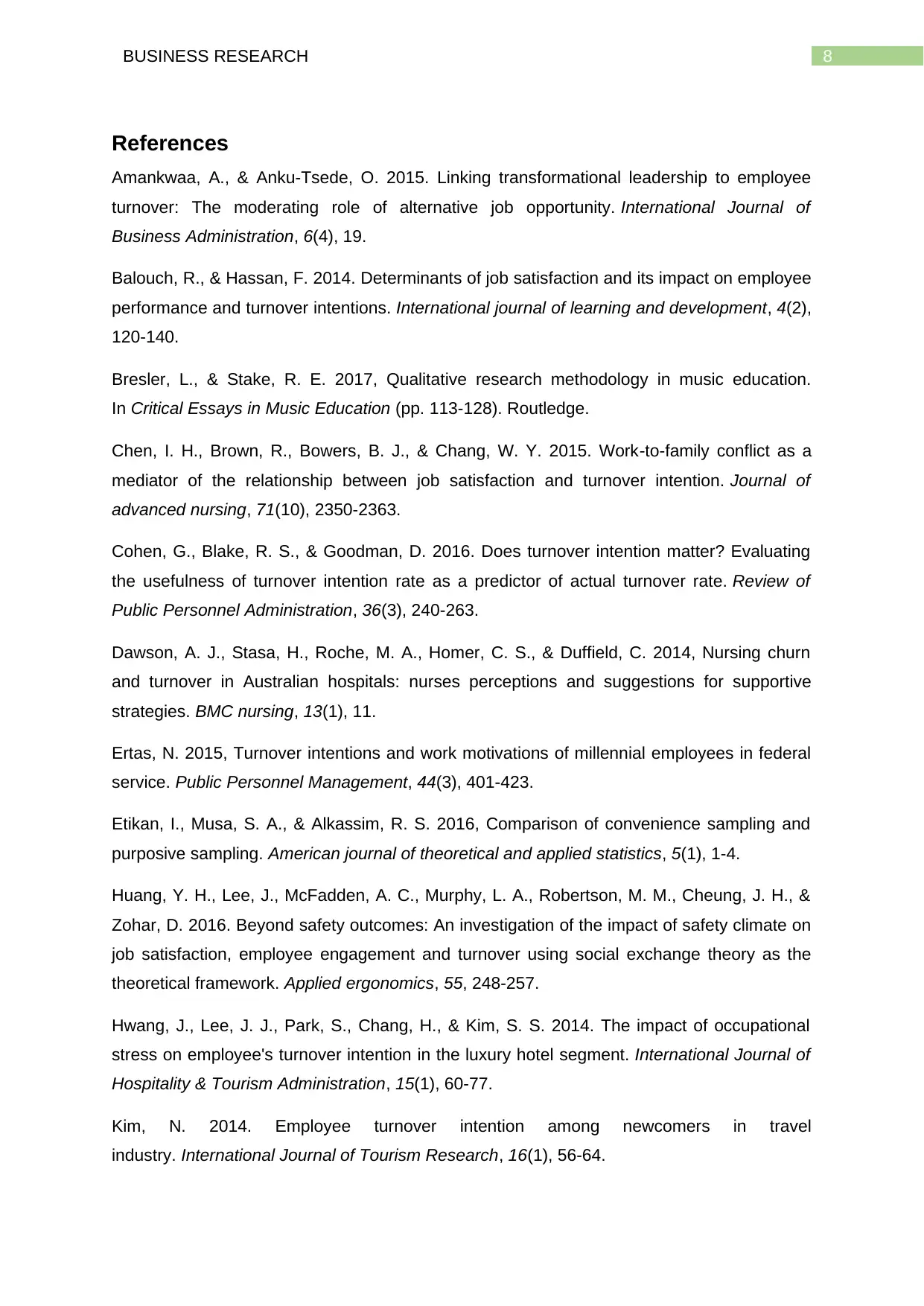
8BUSINESS RESEARCH
References
Amankwaa, A., & Anku-Tsede, O. 2015. Linking transformational leadership to employee
turnover: The moderating role of alternative job opportunity. International Journal of
Business Administration, 6(4), 19.
Balouch, R., & Hassan, F. 2014. Determinants of job satisfaction and its impact on employee
performance and turnover intentions. International journal of learning and development, 4(2),
120-140.
Bresler, L., & Stake, R. E. 2017, Qualitative research methodology in music education.
In Critical Essays in Music Education (pp. 113-128). Routledge.
Chen, I. H., Brown, R., Bowers, B. J., & Chang, W. Y. 2015. Work‐to‐family conflict as a
mediator of the relationship between job satisfaction and turnover intention. Journal of
advanced nursing, 71(10), 2350-2363.
Cohen, G., Blake, R. S., & Goodman, D. 2016. Does turnover intention matter? Evaluating
the usefulness of turnover intention rate as a predictor of actual turnover rate. Review of
Public Personnel Administration, 36(3), 240-263.
Dawson, A. J., Stasa, H., Roche, M. A., Homer, C. S., & Duffield, C. 2014, Nursing churn
and turnover in Australian hospitals: nurses perceptions and suggestions for supportive
strategies. BMC nursing, 13(1), 11.
Ertas, N. 2015, Turnover intentions and work motivations of millennial employees in federal
service. Public Personnel Management, 44(3), 401-423.
Etikan, I., Musa, S. A., & Alkassim, R. S. 2016, Comparison of convenience sampling and
purposive sampling. American journal of theoretical and applied statistics, 5(1), 1-4.
Huang, Y. H., Lee, J., McFadden, A. C., Murphy, L. A., Robertson, M. M., Cheung, J. H., &
Zohar, D. 2016. Beyond safety outcomes: An investigation of the impact of safety climate on
job satisfaction, employee engagement and turnover using social exchange theory as the
theoretical framework. Applied ergonomics, 55, 248-257.
Hwang, J., Lee, J. J., Park, S., Chang, H., & Kim, S. S. 2014. The impact of occupational
stress on employee's turnover intention in the luxury hotel segment. International Journal of
Hospitality & Tourism Administration, 15(1), 60-77.
Kim, N. 2014. Employee turnover intention among newcomers in travel
industry. International Journal of Tourism Research, 16(1), 56-64.
References
Amankwaa, A., & Anku-Tsede, O. 2015. Linking transformational leadership to employee
turnover: The moderating role of alternative job opportunity. International Journal of
Business Administration, 6(4), 19.
Balouch, R., & Hassan, F. 2014. Determinants of job satisfaction and its impact on employee
performance and turnover intentions. International journal of learning and development, 4(2),
120-140.
Bresler, L., & Stake, R. E. 2017, Qualitative research methodology in music education.
In Critical Essays in Music Education (pp. 113-128). Routledge.
Chen, I. H., Brown, R., Bowers, B. J., & Chang, W. Y. 2015. Work‐to‐family conflict as a
mediator of the relationship between job satisfaction and turnover intention. Journal of
advanced nursing, 71(10), 2350-2363.
Cohen, G., Blake, R. S., & Goodman, D. 2016. Does turnover intention matter? Evaluating
the usefulness of turnover intention rate as a predictor of actual turnover rate. Review of
Public Personnel Administration, 36(3), 240-263.
Dawson, A. J., Stasa, H., Roche, M. A., Homer, C. S., & Duffield, C. 2014, Nursing churn
and turnover in Australian hospitals: nurses perceptions and suggestions for supportive
strategies. BMC nursing, 13(1), 11.
Ertas, N. 2015, Turnover intentions and work motivations of millennial employees in federal
service. Public Personnel Management, 44(3), 401-423.
Etikan, I., Musa, S. A., & Alkassim, R. S. 2016, Comparison of convenience sampling and
purposive sampling. American journal of theoretical and applied statistics, 5(1), 1-4.
Huang, Y. H., Lee, J., McFadden, A. C., Murphy, L. A., Robertson, M. M., Cheung, J. H., &
Zohar, D. 2016. Beyond safety outcomes: An investigation of the impact of safety climate on
job satisfaction, employee engagement and turnover using social exchange theory as the
theoretical framework. Applied ergonomics, 55, 248-257.
Hwang, J., Lee, J. J., Park, S., Chang, H., & Kim, S. S. 2014. The impact of occupational
stress on employee's turnover intention in the luxury hotel segment. International Journal of
Hospitality & Tourism Administration, 15(1), 60-77.
Kim, N. 2014. Employee turnover intention among newcomers in travel
industry. International Journal of Tourism Research, 16(1), 56-64.
⊘ This is a preview!⊘
Do you want full access?
Subscribe today to unlock all pages.

Trusted by 1+ million students worldwide
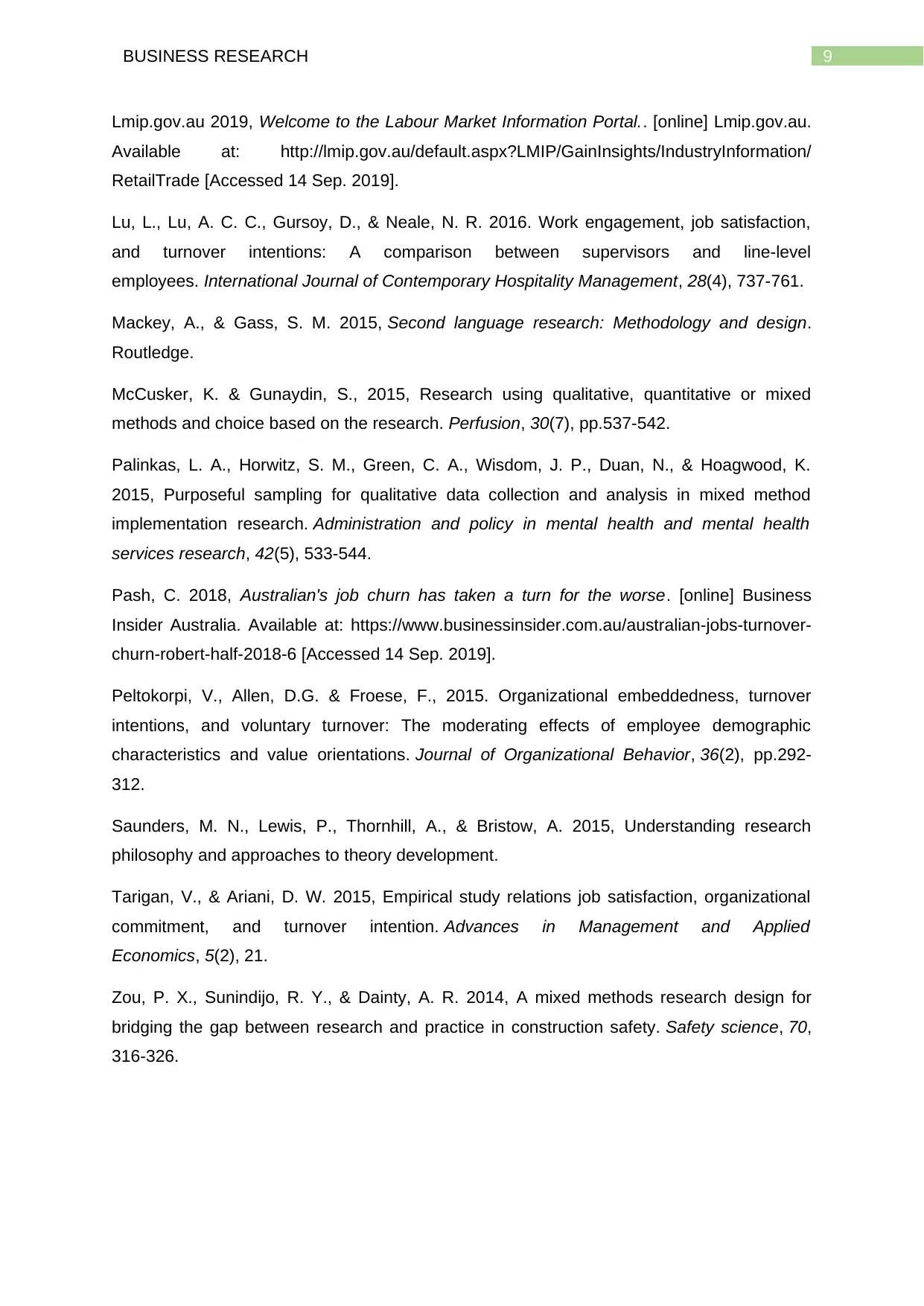
9BUSINESS RESEARCH
Lmip.gov.au 2019, Welcome to the Labour Market Information Portal.. [online] Lmip.gov.au.
Available at: http://lmip.gov.au/default.aspx?LMIP/GainInsights/IndustryInformation/
RetailTrade [Accessed 14 Sep. 2019].
Lu, L., Lu, A. C. C., Gursoy, D., & Neale, N. R. 2016. Work engagement, job satisfaction,
and turnover intentions: A comparison between supervisors and line-level
employees. International Journal of Contemporary Hospitality Management, 28(4), 737-761.
Mackey, A., & Gass, S. M. 2015, Second language research: Methodology and design.
Routledge.
McCusker, K. & Gunaydin, S., 2015, Research using qualitative, quantitative or mixed
methods and choice based on the research. Perfusion, 30(7), pp.537-542.
Palinkas, L. A., Horwitz, S. M., Green, C. A., Wisdom, J. P., Duan, N., & Hoagwood, K.
2015, Purposeful sampling for qualitative data collection and analysis in mixed method
implementation research. Administration and policy in mental health and mental health
services research, 42(5), 533-544.
Pash, C. 2018, Australian's job churn has taken a turn for the worse. [online] Business
Insider Australia. Available at: https://www.businessinsider.com.au/australian-jobs-turnover-
churn-robert-half-2018-6 [Accessed 14 Sep. 2019].
Peltokorpi, V., Allen, D.G. & Froese, F., 2015. Organizational embeddedness, turnover
intentions, and voluntary turnover: The moderating effects of employee demographic
characteristics and value orientations. Journal of Organizational Behavior, 36(2), pp.292-
312.
Saunders, M. N., Lewis, P., Thornhill, A., & Bristow, A. 2015, Understanding research
philosophy and approaches to theory development.
Tarigan, V., & Ariani, D. W. 2015, Empirical study relations job satisfaction, organizational
commitment, and turnover intention. Advances in Management and Applied
Economics, 5(2), 21.
Zou, P. X., Sunindijo, R. Y., & Dainty, A. R. 2014, A mixed methods research design for
bridging the gap between research and practice in construction safety. Safety science, 70,
316-326.
Lmip.gov.au 2019, Welcome to the Labour Market Information Portal.. [online] Lmip.gov.au.
Available at: http://lmip.gov.au/default.aspx?LMIP/GainInsights/IndustryInformation/
RetailTrade [Accessed 14 Sep. 2019].
Lu, L., Lu, A. C. C., Gursoy, D., & Neale, N. R. 2016. Work engagement, job satisfaction,
and turnover intentions: A comparison between supervisors and line-level
employees. International Journal of Contemporary Hospitality Management, 28(4), 737-761.
Mackey, A., & Gass, S. M. 2015, Second language research: Methodology and design.
Routledge.
McCusker, K. & Gunaydin, S., 2015, Research using qualitative, quantitative or mixed
methods and choice based on the research. Perfusion, 30(7), pp.537-542.
Palinkas, L. A., Horwitz, S. M., Green, C. A., Wisdom, J. P., Duan, N., & Hoagwood, K.
2015, Purposeful sampling for qualitative data collection and analysis in mixed method
implementation research. Administration and policy in mental health and mental health
services research, 42(5), 533-544.
Pash, C. 2018, Australian's job churn has taken a turn for the worse. [online] Business
Insider Australia. Available at: https://www.businessinsider.com.au/australian-jobs-turnover-
churn-robert-half-2018-6 [Accessed 14 Sep. 2019].
Peltokorpi, V., Allen, D.G. & Froese, F., 2015. Organizational embeddedness, turnover
intentions, and voluntary turnover: The moderating effects of employee demographic
characteristics and value orientations. Journal of Organizational Behavior, 36(2), pp.292-
312.
Saunders, M. N., Lewis, P., Thornhill, A., & Bristow, A. 2015, Understanding research
philosophy and approaches to theory development.
Tarigan, V., & Ariani, D. W. 2015, Empirical study relations job satisfaction, organizational
commitment, and turnover intention. Advances in Management and Applied
Economics, 5(2), 21.
Zou, P. X., Sunindijo, R. Y., & Dainty, A. R. 2014, A mixed methods research design for
bridging the gap between research and practice in construction safety. Safety science, 70,
316-326.
1 out of 10
Related Documents
Your All-in-One AI-Powered Toolkit for Academic Success.
+13062052269
info@desklib.com
Available 24*7 on WhatsApp / Email
![[object Object]](/_next/static/media/star-bottom.7253800d.svg)
Unlock your academic potential
Copyright © 2020–2025 A2Z Services. All Rights Reserved. Developed and managed by ZUCOL.





